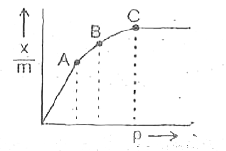The slopes between pV versus V and pV versus p at constant temperature ae respectively
zero and 1
1 and zero
zero and zero
1/2 and 1
The correct Answer is:C
To solve the problem of finding the slopes between PV versus V and PV versus P at constant temperature, we can follow these steps:
Step 1: Understand the Ideal Gas Law
The ideal gas law is given by the equation:
PV=nRT
where:
- P = pressure
- V = volume
- n = number of moles of gas
- R = universal gas constant
- T = temperature
At constant temperature, nRT is a constant.
Step 2: Analyze the First Slope (PV vs. V)
To find the slope of the graph of PV versus V:
- Since PV=nRT is constant, we can express this as:
PV=C(whereC=nRT)
- Rearranging gives:
P=CV
This indicates that as V increases, P decreases, and the relationship is hyperbolic.
However, if we consider PV as a function of V:
- The value of PV remains constant regardless of changes in V.
- Therefore, when plotting PV against V, the graph will be a horizontal line, indicating that the slope is 0.
Step 3: Analyze the Second Slope (PV vs. P)
Now, we find the slope of the graph of PV versus P:
- From the ideal gas equation, we can express V as:
V=CP
- This shows that as P increases, V decreases, again indicating a hyperbolic relationship.
However, if we consider PV as a function of P:
- The value of PV remains constant regardless of changes in P.
- Therefore, when plotting PV against P, the graph will also be a horizontal line, indicating that the slope is again 0.
Conclusion
Thus, the slopes between PV versus V and PV versus P at constant temperature are both 0. Therefore, the answer is:
0 and 0
Final Answer
The correct option is 0 and 0.
---
The ideal gas law is given by the equation:
PV=nRT
where:
- P = pressure
- V = volume
- n = number of moles of gas
- R = universal gas constant
- T = temperature
To find the slope of the graph of PV versus V:
- Since PV=nRT is constant, we can express this as:
PV=C(whereC=nRT)
- Rearranging gives:
P=CV
This indicates that as V increases, P decreases, and the relationship is hyperbolic.
- The value of PV remains constant regardless of changes in V.
- Therefore, when plotting PV against V, the graph will be a horizontal line, indicating that the slope is 0.
Now, we find the slope of the graph of PV versus P:
- From the ideal gas equation, we can express V as:
V=CP
- This shows that as P increases, V decreases, again indicating a hyperbolic relationship.
- The value of PV remains constant regardless of changes in P.
- Therefore, when plotting PV against P, the graph will also be a horizontal line, indicating that the slope is again 0.
Thus, the slopes between PV versus V and PV versus P at constant temperature are both 0. Therefore, the answer is:
0 and 0
The correct option is 0 and 0.
Similar Questions
Knowledge Check
The slope of the plot between pV and p at constant temperature is
AnegativeBpositiveC1/2DzeroSlop between pV and p at constant temperature is
Aslope between pV and p is zeroBslope between pV and p is 1Cslope between pV and p is 12Dslope between pV and p is 1√2Slope of the plot between V and P at constant temperature
AzeroB1C1//2D1√2
Draw a graph of temperature versus time.
View SolutionThe slope of the plot between pV and p at constant temperature is
View SolutionThe slope of the plot between pV and p at constant temperature is
View SolutionAssertion: The plot of volume (V) versus pressure (P) at constant temperature is a hyperbola in the first quadrant.
Reason: V∝1/P at constant temperature.
View SolutionThe graph plotted against adsorption versus pressure P at constant temperature, the Freundich equation at A, B, C respectively are (if n > 1)

View Solution
